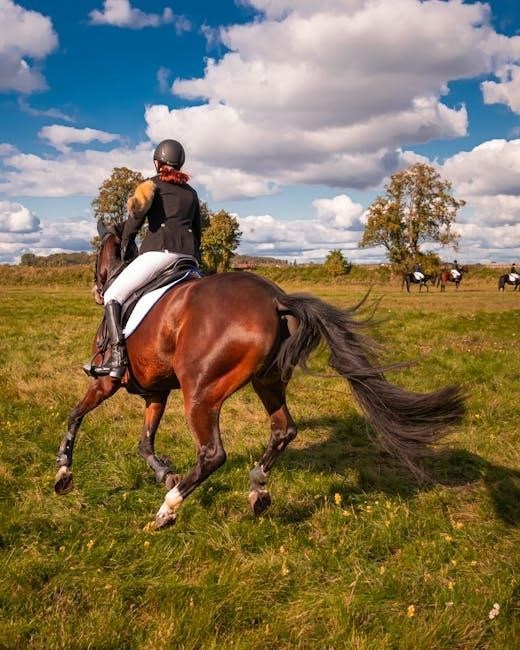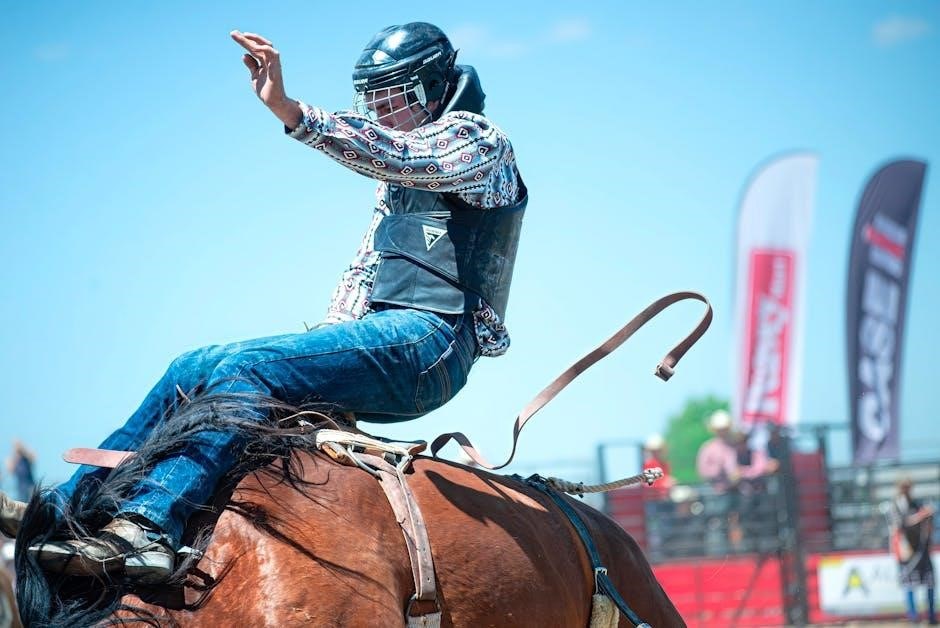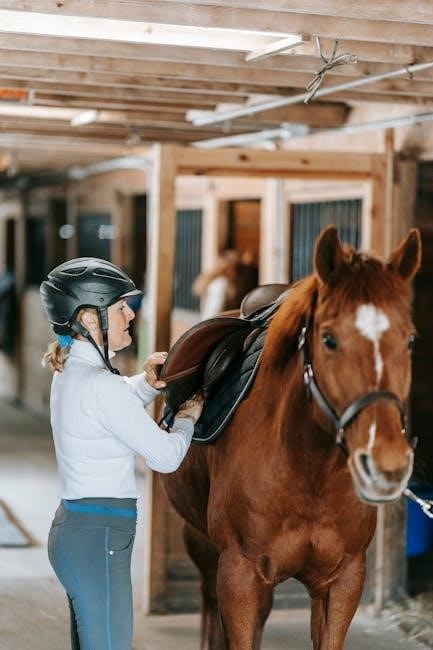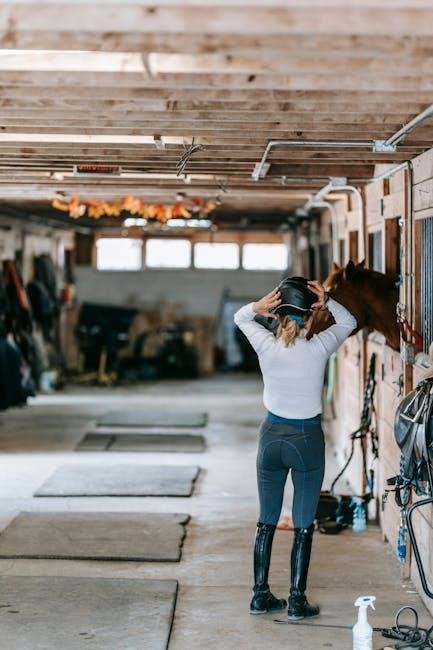
A proper-fitting helmet is crucial for safety and comfort while riding. With various brands and sizes available, understanding how to choose the right one is essential. Helmet fit impacts protection, making it vital to explore sizing standards, measurement techniques, and features like MIPS technology for enhanced safety.
1.1 Importance of Proper Helmet Fit
A well-fitting helmet is critical for safety and comfort. It ensures optimal protection by absorbing impact effectively, reducing injury risks. A proper fit prevents shifting during riding, minimizing distractions. Ill-fitting helmets can compromise safety and cause discomfort. Advanced features like MIPS technology enhance protection, but only if the helmet fits correctly. Proper sizing is essential for maximizing safety and performance.
1.2 Overview of Helmet Sizing Standards
Horse riding helmet sizing standards ensure safety and comfort by providing consistent measurements. Most helmets are sized by head circumference, with brands offering specific charts. Advanced features like MIPS technology enhance protection. Proper sizing ensures the helmet stays secure and absorbs impact effectively. Measuring accurately and comparing to size charts guarantees the best fit for optimal safety and performance.
Understanding Helmet Size and Fit
A well-fitting helmet ensures safety and comfort by matching head shape and size. Proper fit prevents shifting, providing reliable protection and confidence while riding.
2.1 How Helmet Sizes Are Determined
Helmet sizes are determined by measuring head circumference and comparing it to brand-specific size charts. Most helmets are sized in small, medium, or large categories, with measurements ranging from 20 to 25 inches. While head shape can influence fit, circumference remains the primary factor in determining size. Proper measurement ensures optimal safety and comfort.
2.2 The Role of Head Shape in Sizing
Head shape significantly impacts helmet fit, with common types being round, oval, or long oval. Helmets like the Tipperary MIPS accommodate 95% of riders, while the One K Defender suits long oval shapes. Proper fit ensures safety and comfort, so trying helmets is essential. Brands design helmets to fit various head shapes, enhancing protection and wearer satisfaction.
2.3 Key Features of a Well-Fitting Helmet
A well-fitting helmet ensures safety and comfort, with features like secure straps, breathable padding, and a snug yet not tight fit. MIPS technology adds protection against rotational forces, while adjustable systems customize fit. Proper fit prevents shifting during rides, ensuring maximum protection and rider confidence. Quality helmets balance durability and comfort, making them essential for equestrian activities.

Measuring Your Head for the Perfect Fit
Use a flexible measuring tape or string to measure around your head just above your eyebrows and ears. Ensure accuracy for a safe, comfortable fit.
3.1 Step-by-Step Measurement Guide

Position a flexible measuring tape or string around your head, just above your eyebrows and ears. 2. Ensure the tape is level and not too tight or loose. 3. Take note of the circumference in centimeters or inches. 4. Compare your measurement to the helmet size chart for an accurate fit. 5. If unsure, consider having someone assist for precision.
3.2 Tools and Methods for Accurate Measurement
Use a flexible measuring tape or non-stretch string to ensure accuracy. Wrap it around your head, keeping the tape level and snug but not tight. A yardstick can help measure the string’s length. For consistency, maintain the same technique each time. Having someone assist can improve precision. Avoid stretchy materials to prevent inaccurate readings.
3.3 Common Mistakes to Avoid During Measurement
Measuring your head incorrectly can lead to a poor fit, compromising safety and comfort. Avoid using stretchy materials, as they may distort measurements. Ensure the tape isn’t too tight or too loose. Inconsistent placement, such as tilting the tape, can also cause inaccuracies. Always use a flexible measuring tape and maintain consistent technique for reliable results.

How to Read a Helmet Size Chart
Compare your head measurement to the chart, ensuring accuracy for a safe and comfortable fit. Consider brand-specific sizing and adjustable features to optimize your helmet choice.
4.1 Interpreting Size Charts for Different Brands
Each brand has unique sizing standards, so compare your head measurement carefully. Charles Owen and GPA offer detailed charts, while Troxel sizes may vary slightly. Always check the specific brand’s guide to ensure accuracy. Adjustable features and MIPS technology can enhance fit and safety, making it crucial to align your size with the brand’s specifications for optimal protection.
4.2 Comparing Measurements Across Brands
Comparing measurements across brands is essential due to varying sizing standards. For instance, Ovation and Troxel may differ slightly in their size ranges. Always refer to the specific brand’s chart to ensure accuracy. Even a 1-inch difference can impact fit and safety. Use a flexible tape measure and consider adjustable features for the best results.
4.3 Understanding Size Ranges and Adjustability
Understanding size ranges and adjustability ensures a secure fit. Brands like Ovation and Troxel offer varied sizing, while Tipperary MIPS fits 95% of head shapes due to its adjustable features. Always check the size chart and adjustability options to ensure optimal fit and safety. Proper adjustability ensures the helmet stays secure during rides, enhancing both comfort and protection.

Trying On Helmets: Tips and Tricks
Trying on helmets ensures proper fit and comfort. Visit a tack store for professional fitting. If unavailable, measure accurately and compare with size charts. Prioritize comfort and safety.
5.1 The Importance of Trying Before Buying
Trying helmets before purchasing ensures proper fit, comfort, and safety. Visit a tack store for professional fitting. Brands like Tipperary MIPS fit 95% of riders. Poor fit can cause discomfort or inadequate protection. Measure accurately and compare with size charts. Prioritize comfort and safety to avoid potential risks during rides.
5.2 How to Assess Fit and Comfort
Ensure the helmet sits level on your head, with the front low enough to protect your forehead. The fit should be snug but not tight, allowing one finger between the padding and your head. Check for even pressure and no hotspots. The helmet should stay in place when moving without feeling restrictive. Proper fit ensures safety and comfort during rides.
5.3 Adjusting Helmets for Optimal Fit
Use the helmet’s adjustable fit system to ensure a snug, even fit. Tighten or loosen the dial or straps to avoid pressure points. The helmet should feel secure but not restrictive. Check the fit while moving to ensure stability. Proper adjustment ensures safety and comfort, allowing you to ride confidently without distractions.

Factors That Affect Helmet Fit
Hair styles, seasonal changes, and helmet padding can influence fit. Hair styles may require adjustments, while seasonal changes can affect how the helmet sits. Padding and liners also play a role in achieving the perfect fit.
6.1 Hair Styles and Their Impact on Fit
Different hairstyles can affect helmet fit. Long hair or braids may require adjusting the helmet’s padding or size. Volume at the top can cause the helmet to sit higher, while ponytails may need specific accommodations. Ensuring the helmet fits snugly without pressure points is key. Some helmets, like the Tipperary MIPS, are designed to accommodate various head shapes and hairstyles, offering better adaptability for riders.
6.2 Seasonal Changes and Helmet Fit
Seasonal changes can impact helmet fit. In summer, sweat may cause padding to compress, requiring more frequent adjustments. During winter, adding layers or thicker hairstyles can alter fit, necessitating adjustments to the helmet’s fit system or padding. Ensuring a snug, comfortable fit year-round is crucial for safety and comfort while riding.
6.3 The Role of Helmet Padding and Liners
Helmet padding and liners play a crucial role in ensuring a secure, comfortable fit. They absorb sweat, reduce pressure points, and provide additional protection. Over time, padding may compress, affecting fit. Replacing worn-out liners and adjusting padding can maintain optimal helmet performance and safety. Properly fitted padding ensures the helmet stays stable and comfortable during rides.

Advanced Features in Modern Helmets
Modern helmets feature MIPS technology for enhanced impact protection, advanced ventilation systems for breathability, and adjustable fit systems to ensure a secure, customizable fit for various head shapes.
7.1 MIPS Technology and Its Benefits
MIPS (Multi-directional Impact Protection System) enhances safety by reducing brain strain from rotational forces during impacts. It adds a low-friction layer that allows the helmet to slide slightly, minimizing concussion risks. While more expensive, MIPS-equipped helmets like the One K Defender offer superior protection, especially for jumping or high-speed events, making them a worthwhile investment for serious riders.
7.2 Ventilation Systems for Comfort
Modern helmets feature advanced ventilation systems to regulate temperature and humidity. Strategically placed vents and airflow channels ensure cool air circulation, preventing overheating during long rides. This enhances rider comfort, especially in warm climates, without compromising safety. Proper ventilation also helps maintain focus and performance, making it a key feature for both casual and competitive riders.
7.3 Adjustable Fit Systems
Adjustable fit systems allow riders to customize their helmet’s fit for optimal comfort and safety. Features like dial-fit or slide-fit systems enable precise adjustments to accommodate various head shapes and sizes. These mechanisms ensure a secure fit, reducing movement during riding. Additionally, they cater to seasonal changes, such as wearing thicker hair styles or different headwear underneath, ensuring consistent protection and comfort year-round.

Common Mistakes to Avoid
Common errors include buying helmets too tight or loose, ignoring proper fit, and not replacing helmets after impacts. These oversights compromise safety and comfort, emphasizing the need for careful selection and maintenance to ensure optimal protection while riding.
8.1 Buying a Helmet That Is Too Tight or Too Loose
Buying a helmet that is too tight can cause discomfort and pressure points, while a loose helmet may shift during riding, reducing protection. Both scenarios compromise safety and comfort. Proper fit ensures the helmet stays securely in place, providing optimal protection without causing discomfort. Always prioritize accurate sizing to avoid these common mistakes.
8.2 Ignoring the Importance of Proper Fit
Ignoring proper fit can lead to reduced protection and discomfort. A poorly fitting helmet may shift during riding, compromising safety. It can also cause pressure points or lack of coverage, increasing injury risk. Prioritizing fit ensures optimal protection and comfort, making it a critical factor in choosing the right helmet for horse riding.
8.3 Not Replacing Helmets After a Fall
Failing to replace a helmet after a fall can compromise safety. Even if no visible damage exists, internal structures may be weakened, reducing protection. Many helmets, especially those with MIPS technology, are designed for single-impact use. Ignoring this can lead to inadequate safety in future incidents, making regular inspections and timely replacements crucial for rider protection.
Caring for Your Helmet
Regular maintenance ensures your helmet remains safe and functional. Clean with mild soap, avoid harsh chemicals, and store in a cool, dry place. Replace after significant impacts, even if no visible damage, to maintain protection. Proper care extends the helmet’s lifespan and performance, especially for advanced models with MIPS technology.
9.1 Cleaning and Maintenance Tips
Regularly clean your helmet with mild soap and a soft cloth to remove dirt and sweat. Avoid harsh chemicals or abrasive materials that could damage the exterior or padding. Allow the helmet to air dry naturally, avoiding direct sunlight. Inspect for cracks or worn padding and replace liners as needed. Proper maintenance ensures optimal safety and extends the helmet’s lifespan.
9.2 Storage Best Practices
Store your helmet in a cool, dry place away from direct sunlight to prevent degradation. Use a breathable helmet bag to protect it from dust and scratches. Avoid stacking objects on top of the helmet, as this can cause pressure damage. Keep it away from pets or pests that might chew on it. Regularly inspect for signs of wear or damage during storage.
9.3 When to Replace Your Helmet
Replace your helmet immediately after any impact or crash, even if no visible damage is present. Helmets should also be replaced every 5 years, as materials degrade over time. Look for signs of wear, such as cracks, dents, or compressed padding, which indicate the helmet may no longer provide adequate protection. Always follow the manufacturer’s guidelines for replacement.

Troubleshooting Common Fit Issues
Addressing fit issues ensures safety and comfort. Common problems include helmets feeling too tight, loose, or misaligned. Check padding, adjustability, and head shape compatibility to resolve discomfort and instability.
10.1 What to Do If the Helmet Feels Uncomfortable
If your helmet feels uncomfortable, check the padding for compression or misplacement. Adjust the fit system or try different sizes. Ensure proper alignment and consider head shape compatibility. If issues persist, consult a professional fitter or explore other brands. Discomfort can compromise safety and performance, so addressing it promptly is crucial for optimal protection and riding experience.
10.2 Adjusting for Different Head Shapes
Different head shapes, such as oval, round, or long oval, require specific helmet adjustments. Use adjustable dials or pads to customize the fit. Brands like Tipperary MIPS helmets cater to 95% of head shapes. Ensure proper alignment and snugness without pressure points. Trying helmets on is crucial for determining the best fit for your unique head shape and ensuring optimal safety and comfort.
10.3 Solving Issues with Helmet Stability
Ensure a stable fit by adjusting the helmet’s retention system and pads. For oval or round heads, use additional padding to prevent shifting. Brands like Tipperary MIPS helmets offer excellent adjustability. If the helmet moves during riding, check the fit and tighten the chin strap. Proper alignment and snugness are key to maintaining stability and safety while riding.
A well-fitting helmet ensures safety and comfort. Always prioritize proper fit, consider advanced features like MIPS technology, and try helmets before buying for optimal protection and performance.
11.1 Recap of Key Points
Proper helmet fit is essential for safety and comfort. Measure accurately, consider head shape, and try helmets before buying. Advanced features like MIPS technology enhance protection. Regular maintenance and timely replacement ensure optimal performance. Prioritize quality and fit to maximize safety while riding.
11.2 Final Tips for Choosing the Right Helmet
Always prioritize proper fit and comfort; Try helmets before buying if possible, and consider your riding style and needs. Invest in advanced safety features like MIPS technology for added protection. Seek professional fitting guidance and ensure regular maintenance for optimal performance. Remember, a well-chosen helmet is a vital investment in your safety and riding experience.

Additional Resources
Explore top brands like Charles Owen and GPA. Visit SmartPak Equine or Riding Warehouse for guides. Professional fittings are available at local tack shops or through experts like Roy Burek.
12.1 Recommended Brands and Models
Top brands include Ovation, Troxel, and One K, known for quality and safety. The Tipperary MIPS helmet is highly recommended for its advanced protection. Charles Owen and GPA offer premium options, while Samshield is favored for style and fit. These brands provide reliable choices for riders seeking durability and comfort. Explore these models at retailers like SmartPak Equine or Riding Warehouse.
12.2 Where to Find Professional Fittings
Visit local tack stores or equestrian shops for professional helmet fittings. Retailers like SmartPak Equine and Riding Warehouse often offer expert advice. Some brands, like Charles Owen, provide trained fitters to ensure a perfect fit. If in-person options are limited, online resources and videos from professionals like Roy Burek or Marina and Brie can guide you. Always prioritize expert sizing for safety and comfort.
12.3 Online Tools and Guides for Helmet Sizing
Utilize online resources like SmartPak Equine and Riding Warehouse for detailed size charts and guides. Websites often feature video tutorials, such as those by Marina and Brie, to help measure your head accurately. These tools provide step-by-step instructions and comparisons across brands, ensuring a precise fit without in-person visits. Always follow the guides carefully for the best results.